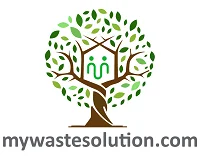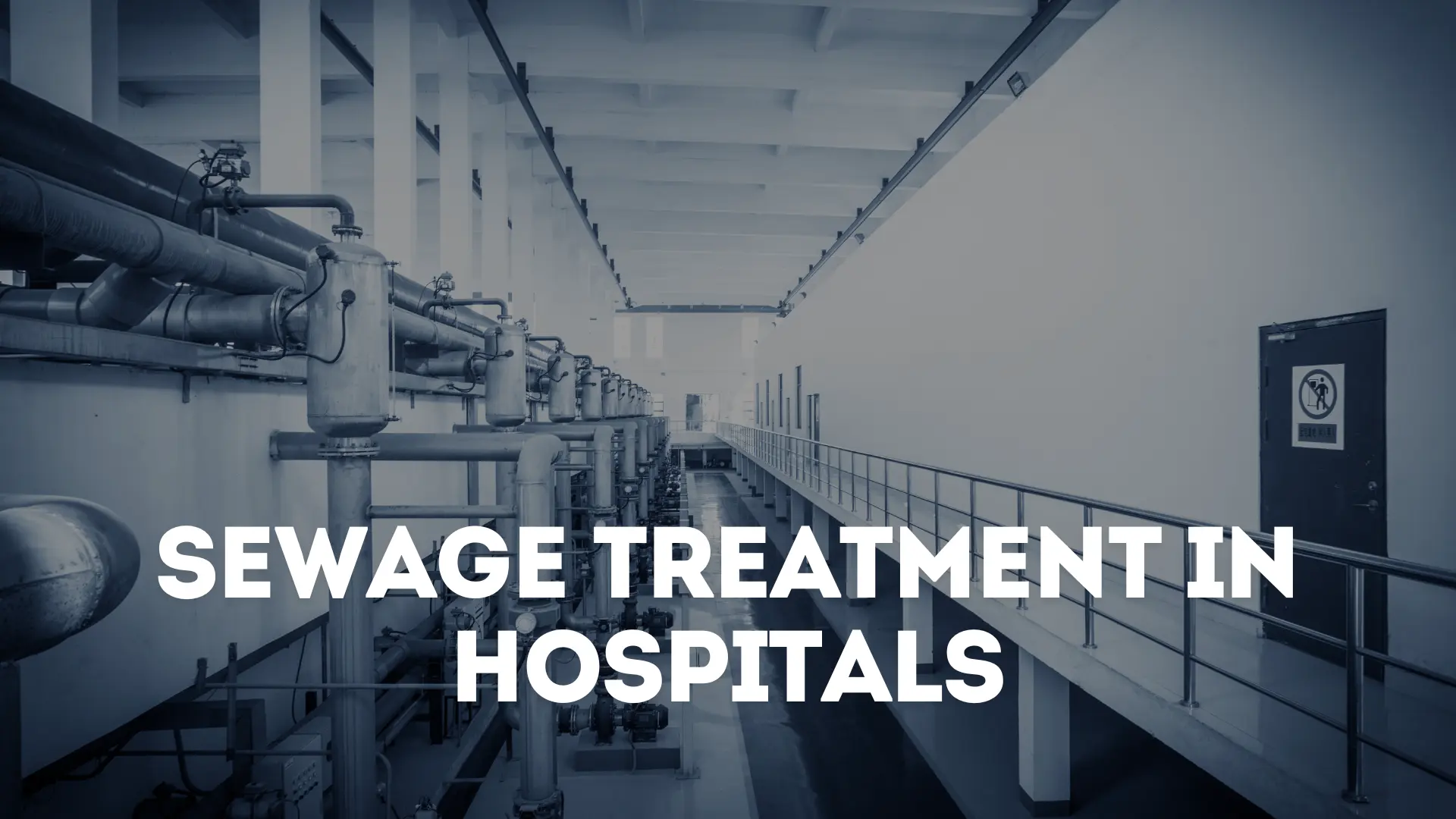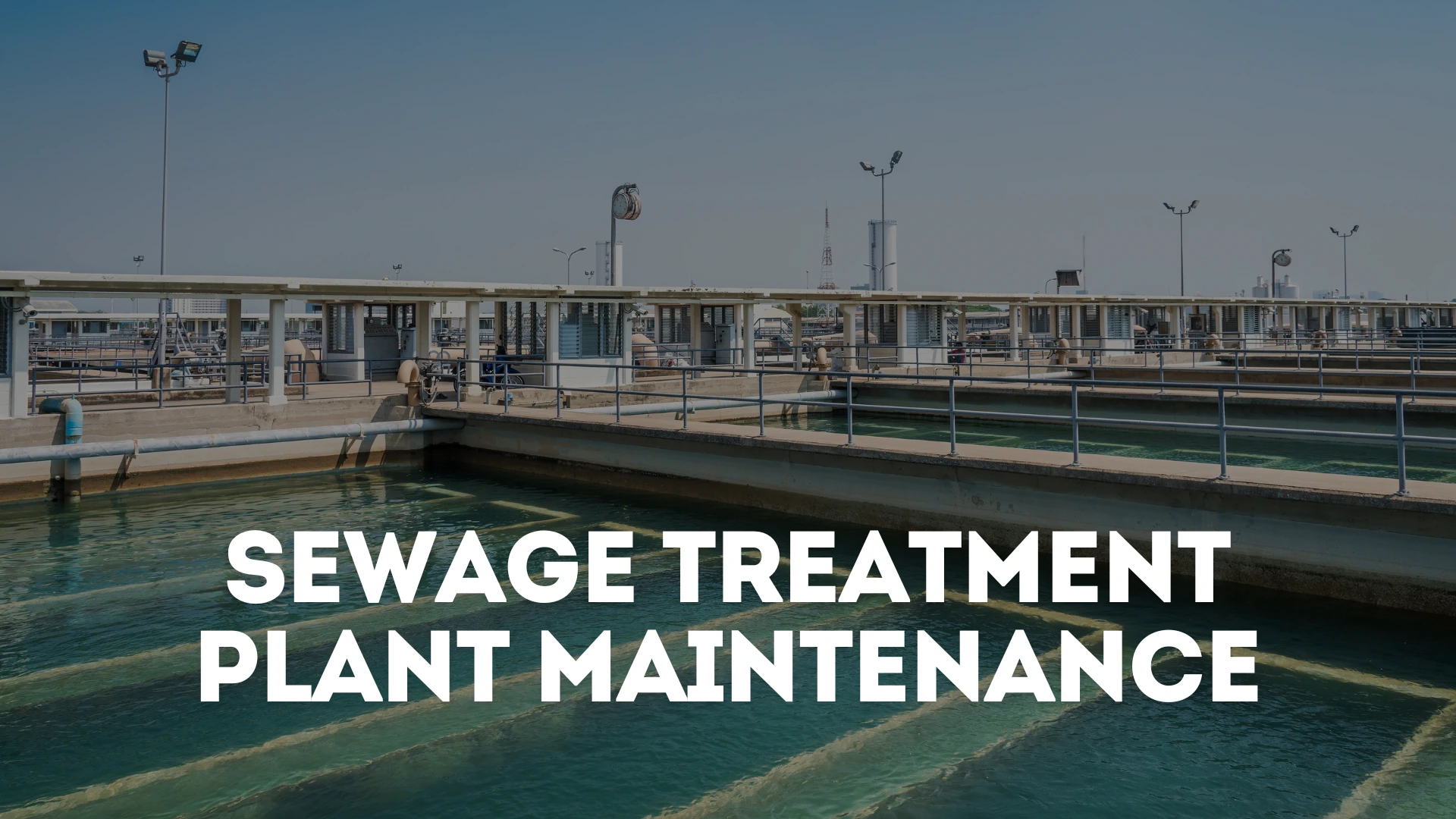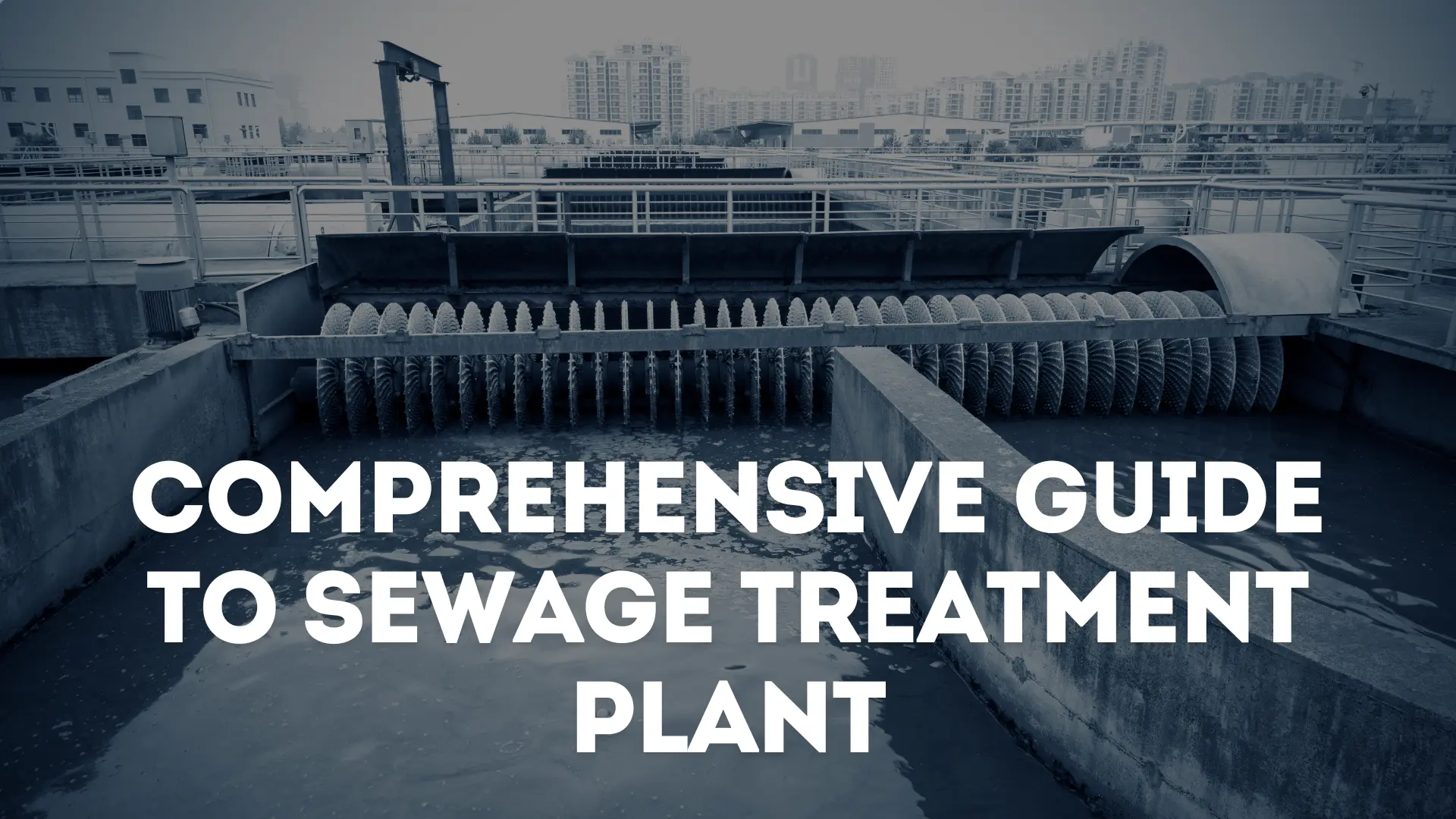I. Introduction
Managing industrial wastewater is vital for environmental impact and progress. Originating from manufacturing, mining, power generation, and chemical production, its composition varies by industry. Common pollutants include heavy metals, chemicals, oils, and organic matter. With decreasing water levels and rising pollution, water contamination is a major concern (Younas et al., 2021). Organic dyes, used for colorfastness in fibers, are notable pollutants (Khan et al., 2022). Untreated industrial waste harms soil, contaminates water, and endangers aquatic ecosystems, with high BOD and COD levels creating “dead zones.” Proper treatment, especially chemical processes, purifies wastewater, removes pollutants, reduces ecological impact, and meets regulatory standards. Adopting water recycling significantly lowers the environmental footprint.
I.A. Overview of Industrial Wastewater
Water is essential for life, supporting ecosystems, agriculture, and human well-being. Responsible management is crucial for sustainability due to increasing industrial demand. Key sectors like textiles, paper production, mining, and food processing are major water consumers. For example, producing a single cotton T-shirt uses over 2,500 liters (Singh et al., 2019), while the paper industry and mining also require significant water (Man et al., 2018; Norgate and Haque, 2010). Food processing involves substantial water use for various stages (Compton et al., 2018; Sodhi et al., 2020). These industries generate large volumes of wastewater with pollutants that pose risks to ecosystems and human health if untreated.
Explore Wastewater Treatment Solutions
Find top machinery, plants, tools, resources, companies, and consultancy for comprehensive industrial wastewater treatment needs.
Effective management of industrial effluents is essential to prevent environmental contamination. Untreated discharge can pollute natural water bodies, harm aquatic life, and disrupt communities that depend on these sources. Toxic substances in effluents can also degrade soil quality, affecting agriculture and terrestrial ecosystems. High Biological Oxygen Demand (BOD) and Chemical Oxygen Demand (COD) levels indicate poor quality, leading to oxygen depletion and “dead zones” in water bodies. Strict regulations mandate the control and treatment of industrial discharges to protect public health and meet environmental standards. Addressing these challenges involves employing various treatment methods—physical, chemical, and biological—to remove contaminants and ensure safe reuse. Balancing industrial growth with environmental sustainability requires ongoing efforts, making the study and implementation of effluent treatment techniques critical for a sustainable future.
Struggling with industrial wastewater issues? Connect with top consultants specializing in wastewater treatment.
Connect NowI.B. Importance of Chemical Treatment
Chemical processes are vital in managing effluents, offering a targeted approach to address contaminants. Research shows these methods enhance wastewater purification, especially when combined with traditional techniques (Hammam et al., 2022). By leveraging unique properties, they effectively remove or neutralize pollutants, ensuring regulatory compliance and sustainable water use. This approach is crucial for breaking down harmful substances and mitigating industrial impacts.
Strategic effluent management minimises adverse effects, protects ecosystems, and promotes sustainable water use, making it indispensable for responsible industrial practices. Here’s why these processes stand out:

- Versatility in Contaminant Removal: These methods can effectively target diverse pollutants such as heavy metals, organic compounds, and suspended solids, offering a comprehensive solution for complex industrial effluents.
- Efficiency in Specific Pollutant Removal: They excel in removing challenging contaminants like heavy metals that are difficult to address with physical methods alone, thereby enhancing overall purification efficiency.
- Adaptability to Varied Industrial Processes: These techniques can be tailored to suit the specific contaminants present in wastewater from different sectors, ensuring adaptability and efficacy across diverse industries.
- Rapid Reaction and Treatment Rates: Chemical reactions proceed rapidly, enabling quicker processing rates compared to biological methods, which is crucial for meeting regulatory standards and preventing environmental harm.
- Effective for Complex Effluent Composition: These methods excel in handling complex compositions through processes like coagulation, flocculation, and precipitation, simultaneously removing various pollutants.
- Neutralization of Acids and Alkaline Substances: They effectively neutralize acidic or alkaline substances in industrial effluents, mitigating their environmental impact and ensuring regulatory compliance.
- Integration with Other Processes: Chemical methods can be integrated with other techniques to create hybrid approaches, optimizing strategies based on specific wastewater characteristics.
While chemical treatment offers significant advantages, a comprehensive wastewater management strategy often combines physical, chemical, and biological methods tailored to the contaminants and industrial processes involved
II. Comparing Chemical Treatment with Other Industrial Wastewater Treatment Methods
Chemical processes stand out as leading methods for wastewater management, showcasing unparalleled efficiency and adaptability. Unlike physical or biological approaches, these methods swiftly degrade contaminants, ensuring a rapid and dependable solution. They excel in eliminating a wide range of pollutants, providing a comprehensive purification approach. Their targeted efficiency is particularly effective against specific contaminants where other methods may struggle. Additionally, these processes often require less space and yield quicker results, making them a practical and versatile choice for diverse industrial settings. This combination of effectiveness and adaptability positions chemical processes as leaders in sustainable and efficient wastewater management, offering a significant advantage over alternative methods.
Find and connect with leading companies specializing in chemical wastewater treatment solutions.
Get Connected Today
III. Chemical Contaminants in Industrial Wastewater
In our exploration of industrial effluents, we encounter a complex mix of contaminants originating from specific industrial processes, each presenting unique challenges to environmental health. Understanding these pollutants is crucial for crafting precise and effective purification strategies. The composition of wastewater varies widely, heavily influenced by its source of origin (Palani et al., 2021). From heavy metals and organic substances to biological impurities and physical particles, the intricate nature of these pollutants underscores the need for meticulous processes in ensuring responsible industrial effluent management. Contaminants such as heavy metals and organic chemicals pose significant challenges to environmental and public health, highlighting the critical importance of specialized wastewater treatment strategies.
III.A. Heavy Metals

Sources: Heavy metals such as lead, mercury, cadmium, and chromium enter industrial wastewater through activities like mining, metal production, electroplating, and chemical processes, where they become significant pollutants.
Impact: These persistent elements severely disrupt ecosystems, affecting aquatic life and disrupting food chains, leading to long-term ecological damage. Even trace amounts of lead, mercury, or cadmium in groundwater pose serious health risks, potentially causing neurological and kidney disorders.
Treatment Challenges: Managing these pollutants in industrial wastewater poses significant challenges due to their stability and persistence. Conventional methods may be inadequate, necessitating advanced techniques such as precipitation, ion exchange, adsorption, and membrane filtration. Tailored and interdisciplinary approaches are essential for implementing effective, environmentally friendly, and sustainable solutions to mitigate the impact of these stubborn contaminants.
III.B. Organic Matter

Sources: Organic chemicals found in wastewater from various manufacturing processes originate from chemical production, pharmaceuticals, and diverse industrial activities. These compounds encompass solvents, pesticides, hydrocarbons, and complex organic substances, contributing to the complexity of wastewater contamination.
Impact: Persistent and often toxic, organic chemicals can disrupt ecosystems by affecting the health and reproductive capabilities of aquatic life. Some pollutants bioaccumulate, posing risks to higher trophic levels. Improper treatment of wastewater may also compromise drinking water quality, potentially leading to adverse health effects from long-term exposure.
Treatment Challenges: Treating organic chemicals presents significant challenges due to the diverse nature of these compounds. Conventional methods may not fully remove complex pollutants, necessitating the use of advanced technologies such as activated carbon adsorption, oxidation (advanced or biological), and membrane filtration. A tailored and sophisticated approach, along with preventive measures through cleaner production practices, are crucial for effective treatment and risk mitigation in wastewater management.
Exploring chemical contaminants reveals a dynamic mix with diverse behaviors. Crafting adaptable treatment strategies for varied industrial sources ensures thorough purification of wastewater, balancing heavy metals and organic chemicals with targeted approaches for efficacy, environmental impact, and sustainability in treatment practices. Managing particles in industrial wastewater involves preventive measures, sound industrial practices, and targeted technologies, contributing to preserving water quality and sustaining aquatic ecosystems.
IV. Types of Chemicals Used
In industrial wastewater treatment, various chemicals play crucial roles in ensuring effective purification.
Coagulants like aluminium sulphate and ferric chloride lead the charge by causing particles to clump together for easier removal.
Flocculants such as polyacrylamide enhance this process, forming larger, denser flocs that aid in sedimentation or filtration.
PH adjusters like lime or sulfuric acid maintain optimal acidity or alkalinity, essential for efficient treatment.
Oxidising agents, including chlorine and hydrogen peroxide, break down pollutants, especially organic compounds, through oxidation reactions.
Reducing agents like sodium bisulfite neutralise excess oxidising agents, preventing adverse effects.
This coordinated use of chemicals ensures that industrial wastewater meets stringent environmental standards, highlighting the importance of targeted chemical treatment for sustainable water management.

Explore the best wastewater treatment machinery and plants for your industrial needs.
Connect TodayV. Common Chemical Treatment Processes
Chemical treatment of industrial wastewater uses various chemicals and processes to remove, neutralize, or transform contaminants, improving water quality for environmental release or reuse. This essential process ensures compliance with environmental regulations, protects ecosystems, and promotes public health. It exemplifies sustainable industrial practices that balance economic activities with environmental responsibility. Methods are chosen based on the specific characteristics of the wastewater and contaminants.
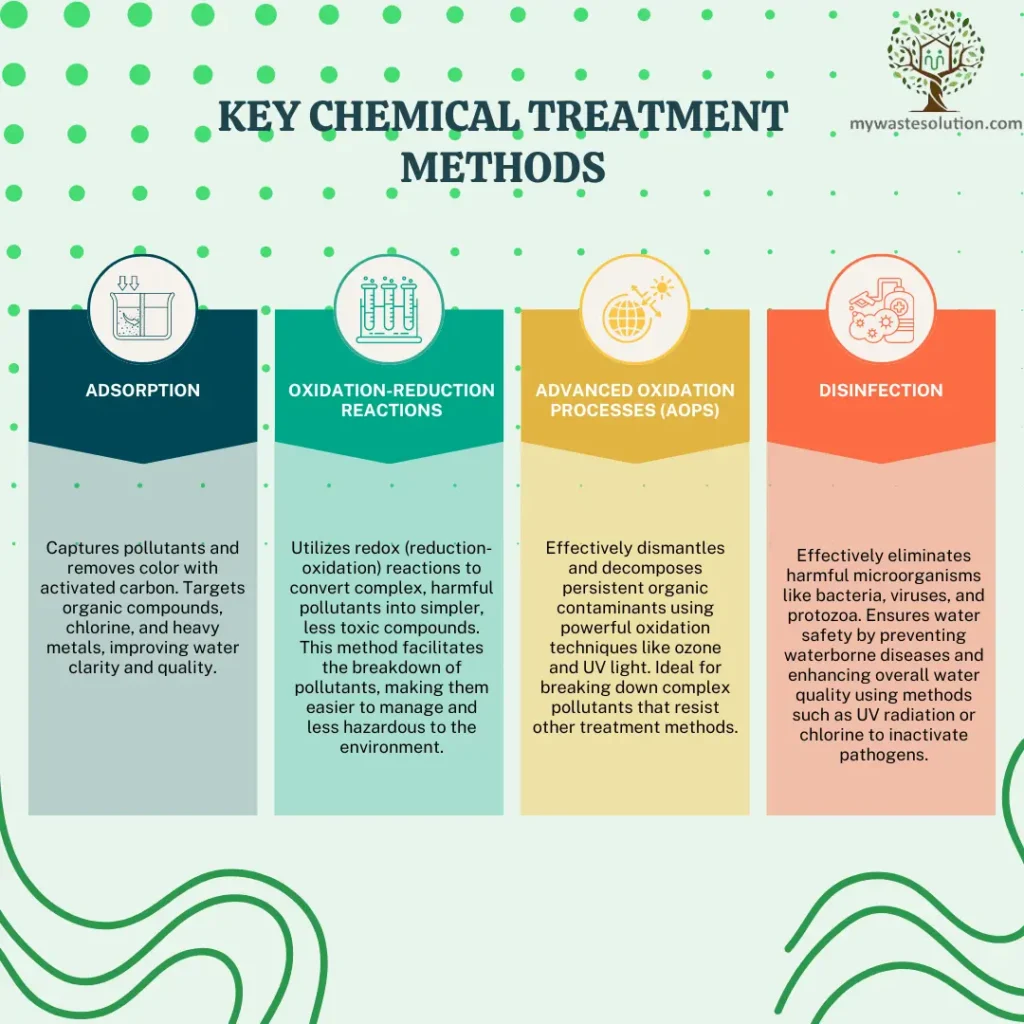
- Coagulation and flocculation:
Coagulation and flocculation are key in industrial wastewater treatment, improving water clarity by removing suspended solids and colloidal particles. Coagulation uses chemical coagulants to neutralize particle charges, causing them to clump together. Flocculation then adds polymer flocculants to form larger, denser flocs through mixing. These processes enhance particle settling and separation, aiding in filtration. Effective coagulation and flocculation depend on precise dosing and pH control, leading to better settling, improved filtration, and more effective removal of fine and colloidal particles.
- Precipitation
Precipitation is a key chemical process in industrial wastewater management, removing dissolved ions like heavy metals by forming insoluble solids. Chemicals added to the water create these solids, which are then separated through sedimentation or filtration. This process effectively addresses dissolved contaminants, reducing heavy metals and inorganic pollutants. Precipitation is crucial for environmental compliance, protecting ecosystems, and supporting aquatic life by lowering toxicity. It also enhances sedimentation and filtration efficiency by reducing soluble contaminants, making it essential for industries to manage wastewater responsibly and promote sustainability.
- Neutralisation
In our industrial effluent management, neutralisation is a critical chemical treatment process used to adjust pH levels effectively. This method involves carefully adding acidic or alkaline substances to counterbalance extreme pH conditions. For example, acidic effluent benefits from alkaline substances such as lime or sodium hydroxide, while sulphuric acid is used to neutralise alkaline wastewater. Beyond pH control, neutralisation plays a vital role in preventing pipe corrosion, safeguarding aquatic ecosystems from pH-related harm, and optimising subsequent biological treatment stages. By bringing pH levels closer to neutral, we ensure compliance with stringent environmental regulations and enhance the efficiency of our treatment systems. Achieving optimal results requires precise dosage control tailored to the unique characteristics of each wastewater stream. Ultimately, neutralisation ensures infrastructure durability, regulatory compliance, and overall treatment efficiency.
- Adsorption
As we delve into the chemical treatment of industrial wastewater, adsorption emerges as a crucial process. This method utilizes adsorbent materials such as activated carbon or specific polymers to attract and capture contaminants. Through this mechanism, pollutants adhere to the adsorbent’s surface, effectively removing organic chemicals, color, and various contaminants from the water. Adsorption is highly valued for its versatility and efficiency in targeting a wide range of pollutants in industrial wastewater. The effectiveness of this process hinges on the surface properties of the adsorbent and the characteristics of the contaminants present. By significantly enhancing water quality and supporting responsible wastewater management practices, adsorption ensures compliance with environmental regulations and promotes sustainable industrial operations. For instance, in treating wastewater from multi-product chemical plants with complex organic compositions, combining adsorption with other treatment methods proves effective in reducing COD levels and eliminating color (Rathi, 2002).
- Ion Exchange
Highly effective for removing targeted ions like heavy metals, ion exchange plays a crucial role in achieving stringent water quality objectives, meeting discharge standards, and facilitating the removal of specific contaminants. Its precision in ion removal and adaptability to diverse wastewater compositions make ion exchange indispensable in industrial wastewater treatment. By selectively eliminating harmful ions such as heavy metals, this method ensures compliance with environmental regulations, safeguards ecosystems, and enhances overall water quality. Ion exchange represents a precise and responsible approach to wastewater management, aligning perfectly with sustainable industrial practices.
- Oxidation-Reduction (Redox) Reaction
When addressing the chemical treatment of industrial effluent, oxidation-reduction (redox) reactions play a crucial role. In our approach, we utilise oxidising and reducing agents to transform pollutants into less harmful substances. To elaborate, oxidation involves the loss of electrons, while reduction involves gaining electrons. These redox reactions effectively treat organic pollutants and reduce the concentration of specific chemicals in wastewater. This process helps us meet stringent water quality standards and minimise environmental impact. Implementing redox reactions is essential for sustainable wastewater management. They ensure the responsible discharge or reuse of treated effluent, contributing significantly to environmental protection and regulatory compliance.
- Advanced Oxidation Processes
Advanced Oxidation Processes (AOPs) encompass a range of chemical treatment methods applied in industrial wastewater treatment. These innovative techniques utilise potent oxidants such as ozone, hydrogen peroxide, or ultraviolet (UV) light to break down complex organic compounds into simpler, less harmful substances. AOPs are particularly effective against refractory organic pollutants that resist conventional treatment methods.The significance of AOPs lies in their ability to degrade persistent pollutants that standard approaches struggle to handle. By employing robust oxidants like ozone or UV light, AOPs ensure thorough removal of complex organic compounds. Their versatility makes them suitable for diverse industrial wastewater compositions, addressing challenging pollutants effectively. AOPs play a pivotal role in achieving stringent environmental standards, safeguarding ecosystems, and supporting resource recovery initiatives. As industrial discharge regulations tighten, AOPs offer an advanced and adaptable solution to tackle complex wastewater challenges. This promotes responsible and sustainable industrial practices.
- Chelation
Chelation is a crucial chemical treatment process used in industrial wastewater treatment to reduce the toxicity of heavy metals. This method involves adding chelating agents like ethylenediaminetetraacetic acid (EDTA) or citric acid, which form stable complexes with metal ions. These complexes prevent the adverse effects of heavy metals, such as precipitation or the formation of insoluble compounds, making the metals less toxic and easier to remove from wastewater. Chelation plays a pivotal role in environmental protection and regulatory compliance by minimising the harmful impact of heavy metal discharge on ecosystems. By efficiently stabilising metals, this process supports responsible industrial practices in wastewater management, ensuring metals are prepared for subsequent treatment processes
- Disinfection
Disinfection is a vital step in industrial wastewater treatment, focused on eliminating or inactivating pathogenic microorganisms present in the effluent. This process holds paramount importance by eradicating or deactivating harmful microorganisms, ensuring the safety of treated water before its discharge or reuse. Common disinfectants include chlorine, ozone, and ultraviolet (UV) light. This treatment prevents the spread of waterborne diseases and safeguards public health by reducing the microbial load in the effluent to acceptable levels. Implementing effective disinfection measures is indispensable for adhering to stringent regulatory standards. Beyond human health concerns, this process contributes to the preservation of aquatic ecosystems and supports responsible water management practices. By maintaining microbial safety and preventing the spread of contaminants, disinfection enhances public confidence in the environmental stewardship of industrial facilities, aligning with both regulatory requirements and community well-being.
VI. Factors Influencing Chemical Treatment
At mywastesolution, we understand that several factors influence the effectiveness of chemical treatment in industrial wastewater. These factors are crucial in selecting appropriate agents and ensuring the success of the process. The flow rate of wastewater through treatment processes influences the contact time between agents and contaminants, essential for effective reactions and pollutant removal. The specific goals of wastewater management, such as reducing toxicity, meeting discharge standards, or facilitating water reuse, influence the selection and sequence of processes. The design and capabilities of infrastructure, including mixing tanks, reactors, and filtration systems, impact the practical application of treatments. Ensuring compatibility with existing equipment is essential for seamless integration and operation. For expert guidance, explore our directory list of chemical waste treatment consultants on mywastesolution.com.
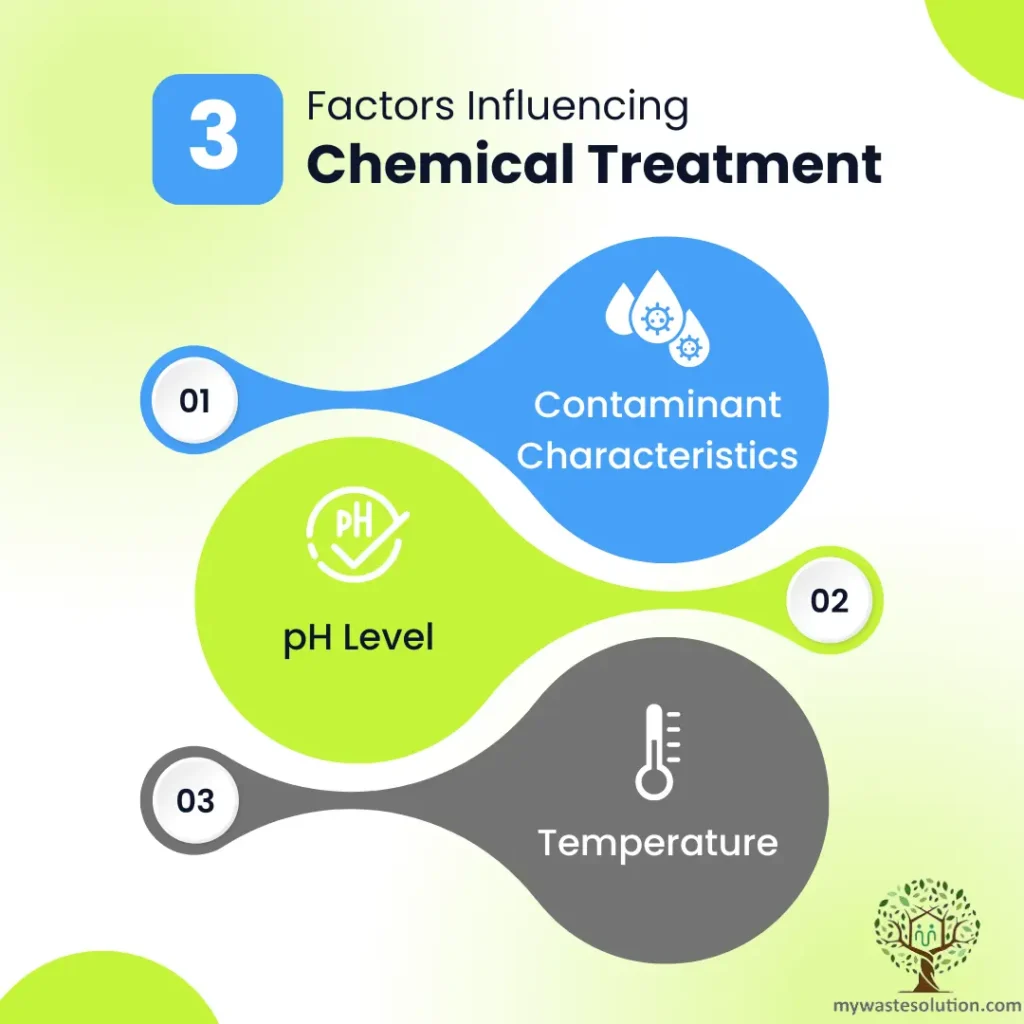
VI.A. Contaminant Characteristics
In our approach to chemical management of industrial wastewater, understanding contaminant characteristics is crucial. These factors define pollutant behavior and guide our selection of effective processes. Organic or inorganic nature determines methods. Organic compounds often respond to oxidation, while inorganic pollutants may require precipitation or chelation. Solubility influences approaches; insoluble pollutants are removed through precipitation or filtration, while soluble ones are targeted via ion exchange or adsorption. Contaminant electrical charge impacts coagulation and flocculation; specific agents are needed for positively or negatively charged particles. Additionally, volatile contaminants require containment during management to prevent environmental emissions. Our comprehensive assessment of composition ensures effective chemical applications, supporting successful and environmentally responsible wastewater management.
VI.B. pH levels
We emphasize the importance of maintaining optimal pH levels for effective chemical treatment in industrial wastewater. pH, indicating acidity or alkalinity, significantly influences various treatment processes:
- Coagulation and Flocculation: pH affects particle charge, crucial for efficient destabilization and floc formation, facilitating easier removal of contaminants.
- Precipitation: pH-dependent precipitation reactions control ion solubility, crucial for forming insoluble precipitates that remove heavy metals and inorganic pollutants.
- Ion Exchange: pH impacts the effectiveness of ion exchange resins, affecting their capacity and selectivity. Operating within recommended pH ranges ensures optimal resin performance.
- Neutralization: Adjusting pH during neutralization prevents corrosion and optimizes subsequent pH-sensitive treatment processes in acidic or alkaline wastewater.
- Adsorption: pH influences the efficiency of adsorption processes, such as activated carbon use, altering material affinities for contaminants.
- Oxidation-Reduction Reactions: pH levels affect the rates of oxidation and reduction reactions, crucial for effectively breaking down organic pollutants.
- Chelation: pH-dependent chelation reactions require optimal conditions for forming stable complexes, thereby reducing heavy metal toxicity.
- Disinfection: pH influences disinfection methods like chlorination, impacting by-product formation and microbial inactivation efficiency.
Monitoring and controlling pH throughout all stages of wastewater management is essential. Deviations can lead to incomplete or inefficient processes, risking operational issues and compromising effluent quality. Understanding and managing pH levels are critical for ensuring successful chemical applications in industrial wastewater plants.
VI.C. Temperature
We recognize the pivotal role of temperature in chemical processes for industrial wastewater. Temperature significantly influences reaction rates, accelerating key processes such as coagulation, flocculation, and oxidation-reduction reactions. Higher temperatures enhance reaction kinetics, speeding up particle destabilization and improving floc formation efficiency, which is crucial for effective removal of contaminants, including organic pollutants. Conversely, lower temperatures can slow these rates, potentially reducing treatment efficiency. Maintaining optimal ranges is therefore essential for ensuring successful pollutant removal and enhancing overall water quality.
Ensuring appropriate conditions throughout the management process is vital for meeting environmental compliance standards and achieving effective chemical treatments in industrial wastewater.
VII. Case Studies on Successful Applications

Transformative Tale: Textile Wastewater Turnaround in Tirupur India
In the heart of Tirupur, India’s renowned “Knitwear Capital,” the textile industry confronted a pressing environmental challenge. Unregulated wastewater discharge, laden with dyes and heavy metals, posed a severe threat to local water bodies. Enter chemical treatment – the unsung hero in this eco-drama.
The Challenge: Tirupur’s textile units navigated through untreated wastewater, prompting an urgent quest for a sustainable solution.
The Chemical Symphony: Coagulants and flocculants took center stage, guiding suspended solids and dye particles toward a cleaner destiny. pH adjustments ensured optimal conditions for subsequent treatments, while advanced oxidation processes (AOPs) with hydrogen peroxide tackled organic complexities.
The Unveiling: The results were striking – a significant reduction in color, chemical oxygen demand (COD), and pollutants. The treated water not only met stringent regulatory standards but also marked a positive shift in the industry’s environmental impact.
Takeaways: Tirupur’s textile narrative underscores the power of a well-orchestrated chemical treatment regimen. By integrating coagulants, flocculants, pH optimization, and AOPs, the Knitwear Capital not only achieved regulatory compliance but also pioneered a story of sustainable transformation.
From Pollution to Purity: A Brewery’s Wastewater Revolution, Bengaluru, India
A prominent brewery in Bengaluru faced a critical challenge with its wastewater, laden with organic compounds and high biochemical oxygen demand (BOD). Struggling to meet environmental compliance, they embarked on a quest for a transformative solution.
The Chemical Symphony: Coagulants like ferric chloride took the lead, initiating particle aggregation, while flocculants such as polyacrylamide formed compact flocs. pH adjustments optimized treatment conditions, complemented by advanced biological treatment and activated carbon adsorption.
The Unveiling: Results were remarkable – significant reductions in BOD, suspended solids, and color. The treated water not only adhered to stringent regulatory standards but also underscored the brewery’s commitment to sustainable practices.
Takeaways: This case illustrates the effectiveness of chemical treatment in the brewery sector. While specific details are generalized here, real-life scenarios from Bengaluru’s brewing industry are extensively documented in industry reports and environmental studies. Interested readers are encouraged to explore detailed reports from relevant authorities and research publications for deeper insights.
VIII. Regulatory Compliance
Navigating the regulatory landscape surrounding the chemical treatment of industrial wastewater is akin to embarking on a journey where environmental responsibility guides our path. As we delve into this realm, we encounter a series of guidelines and standards crafted by government authorities. These regulations serve as our compass, ensuring that our industrial efforts align harmoniously with the well-being of our planet.
VIII.A. Key Aspects of Regulatory Compliance:
Emission Standards: Regulations establish limits on the concentration of specific pollutants that industrial facilities can discharge into water bodies. Compliance involves implementing chemical treatment processes to meet these stringent standards.
Permitting Requirements: Industrial facilities typically need permits that specify conditions for wastewater discharge. Compliance entails obtaining and adhering to these permits, which often outline specific chemical treatment methods and monitoring protocols.
Monitoring and Reporting: Compliance includes regular monitoring of wastewater discharges and reporting results to regulatory authorities. This ensures that chemical treatment effectively reduces pollutant levels to meet regulatory limits.
Waste Disposal Regulations: Proper disposal of chemical sludge and by-products generated during treatment is crucial. Facilities must manage and dispose of these residues in accordance with strict environmental regulations.
Safety and Handling Protocols: Regulatory compliance extends to the safe handling, storage, and transportation of chemicals used in treatment processes. Facilities adhere to guidelines to prevent accidents, spills, and other potential hazards.
Public Notification: In some cases, regulations require facilities to inform the public about their wastewater discharges and the efficacy of chemical treatment in safeguarding the environment.
Compliance with these regulations is essential not only for legal reasons but also to uphold environmental sustainability, protect surrounding communities, and maintain a positive corporate image. Facilities often collaborate closely with environmental agencies to ensure that their chemical treatment practices align seamlessly with regulatory requirements.
IX. Challenges and Future Developments
- Remaining Issues in Chemical Treatment
Navigating efficient industrial wastewater management through chemical treatment faces persistent challenges. Diverse contaminants and variable wastewater compositions demand constant innovation. High treatment costs, including chemicals and energy, pose sustainability challenges.Managing sludge formation during coagulation and flocculation adds complexity, while maintaining optimal pH levels amidst industrial fluctuations requires vigilant monitoring. Residues and by-products present environmental and operational challenges, necessitating sustainable solutions.Balancing stringent regulatory compliance with optimized chemical treatment remains delicate. Addressing emerging contaminants and ensuring stable plant operation amid process changes call for continuous improvement and advanced technologies in wastewater management.
- Emerging Technologies and Innovations
Emerging technologies are set to transform industrial wastewater treatment, offering innovative solutions and paving the way for future advancements:
Nanotechnology Applications: Nanomaterials present new avenues for efficient contaminant removal. Nanostructured catalytic membranes and nanosorbents show immense potential in filtration and remediation processes, offering eco-friendly and energy-efficient solutions.
Membrane Bioreactors (MBRs): Combining biological treatment with membrane filtration, MBRs enhance contaminant removal and produce high-quality effluent in a compact setup.
Artificial Intelligence (AI) and Machine Learning (ML): AI and ML optimize process control, predictive maintenance, and data analysis, improving operational efficiency and reducing energy consumption.
Electrochemical Treatment: Methods like electrocoagulation and electrooxidation are gaining popularity for their ability to effectively remove pollutants, providing a sustainable alternative.
Green Chemistry Approaches: Emphasizing environmentally friendly chemicals and processes, green chemistry reduces the overall environmental footprint of wastewater treatment.
Sustainable Bio-based Solutions: Utilizing bio-based materials such as microbial fuel cells and biodegradable sorbents exemplifies a shift towards sustainable and eco-friendly treatment methods.
Smart Sensor Technologies: Real-time monitoring of water quality parameters via smart sensors enables proactive adjustments and enhances system performance.
Future developments in industrial wastewater treatment will likely enhance integration, efficiency, and environmental sustainability. Anticipated innovations include refined nanotechnology applications, advanced sensing technologies, and holistic approaches to resource recovery from treated wastewater. The ongoing evolution of these technologies promises a more sustainable and effective industrial wastewater treatment landscape.
X. Conclusion
Exploring chemical treatment for industrial wastewater unveils challenges, innovations, and a steadfast commitment to sustainability. Managing diverse contaminants, addressing financial constraints, and adhering to stringent regulatory standards highlight the imperative for ongoing enhancement. Advanced Oxidation Processes, Nanotechnology, and Artificial Intelligence emerge as transformative technologies offering promising, eco-friendly solutions. Striking a balance between regulatory compliance and process optimization necessitates a sustainable approach, exemplified by advancements in green chemistry, bio-based solutions, and smart sensor technologies. Looking forward, the potential of nanotechnology, enhanced sensors, and holistic resource recovery promises a future marked by sustainability, efficiency, and environmental stewardship. Through continuous research and innovation, chemical treatment of industrial wastewater plays a pivotal role in fostering a cleaner, more sustainable industrial landscape.

